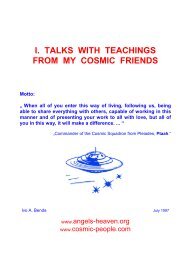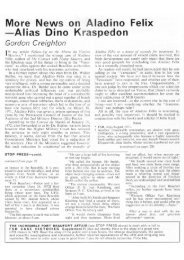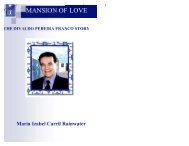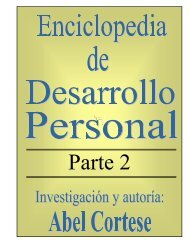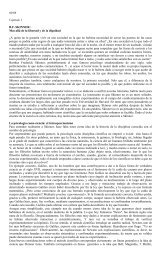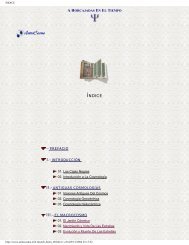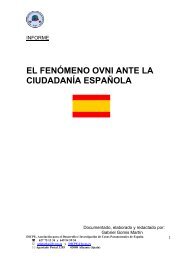The Word That is God
The Word That is God
The Word That is God
Create successful ePaper yourself
Turn your PDF publications into a flip-book with our unique Google optimized e-Paper software.
Pranava. …From the termination ava <strong>is</strong> understood avati: ‘He favors.’ He brings out H<strong>is</strong><br />
devotees from samsara, He leads those in samsara to nirvana, he brings to a devotee unsurpassed<br />
joy, he grants him samadhi to lead him to the highest truth. But all these meanings are<br />
associated with the most intense love of the Lord. …When the Lord <strong>is</strong> continuously worshipped<br />
in the mind by means of th<strong>is</strong> syllable, Om, He gives H<strong>is</strong> grace. …Through Om the Lord <strong>is</strong> met<br />
face to face.” (Shankara, Commentary on the Yoga Sutras)<br />
“It <strong>is</strong> proper to employ Om as a means for practicing worship of <strong>God</strong>. …When the yogi has<br />
understood the identity of Om and Brahman he attracts the grace of the supreme Lord<br />
through Its japa and bhavanam. Bhavanam <strong>is</strong> setting the heart on the Lord Who <strong>is</strong> designated<br />
by Om and brought into the mind by It.” (Shankara, Commentary on the Yoga Sutras)<br />
“Repeating the Om continually <strong>is</strong> the only true worship. It <strong>is</strong> not a word, it <strong>is</strong> <strong>God</strong><br />
Himself.” (Swami Vivekananda, Inspired Talks, Sunday, July 21)<br />
Om, being <strong>God</strong>, should also be worshipped<br />
“In another place it <strong>is</strong> said: ‘<strong>The</strong> <strong>Word</strong>-Brahman <strong>is</strong> the Syllable Om; but the uppermost<br />
part of <strong>That</strong> <strong>is</strong> that which <strong>is</strong> composed [quiet], wordless….’ <strong>That</strong> <strong>is</strong> why one should worship<br />
these both.’” (Maitrayana Upan<strong>is</strong>had 6:22,23)<br />
“<strong>The</strong> Syllable Om <strong>is</strong> to be worshipped as cons<strong>is</strong>ting of Brahman, Who <strong>is</strong> Satchidananda.<br />
…Because it delivers [saves], Om <strong>is</strong> called the Deliverer [Saving One: Taraka]. It should be<br />
known as the saving [delivering] Brahman which should be worshipped–mark th<strong>is</strong> well. ”<br />
(Rama Uttara Tapiniya Upan<strong>is</strong>had)<br />
“<strong>That</strong> which <strong>is</strong> Om <strong>is</strong> the indestructible, the supreme Brahman. <strong>That</strong> alone should be<br />
worshipped. …It <strong>is</strong> called Taraka because it enables one to cross th<strong>is</strong> mundane ex<strong>is</strong>tence<br />
[samsara]. Know that Taraka [Om] alone <strong>is</strong> Brahman and It alone should be worshipped. …He<br />
who knows th<strong>is</strong> becomes immortal.” (Tarasara Upan<strong>is</strong>had)<br />
“Omkara <strong>is</strong> the holiest of holy things. …it <strong>is</strong> holy and full of sanctifying things. One shall<br />
worship Omkara devoid of sound, touch, color, taste and smell.” (Vayu Purana)<br />
“Just as the image of V<strong>is</strong>hnu or any other god <strong>is</strong> regarded as identical with that god (for<br />
purposes of worship), so <strong>is</strong> Om to be treated as Brahman.” (Shankara, Commentary on the<br />
Brihadaranyaka Upan<strong>is</strong>had)<br />
“<strong>The</strong> syllable Om <strong>is</strong> the inmost essence of all essences. It <strong>is</strong> supreme because of Its being<br />
the symbol of the Supreme Self. It <strong>is</strong> competent to be worshipped as the Supreme Self. It <strong>is</strong><br />
competent to take the place of the Supreme Self since It <strong>is</strong> to be worshipped like the Supreme<br />
Self.” (Shankara, Commentary on the Chandogya Upan<strong>is</strong>had)<br />
“<strong>The</strong> Vedic rites are meant for the worship of the very Om because It <strong>is</strong> a symbol of the<br />
Supreme Self. <strong>The</strong> worship of <strong>That</strong> [Om] <strong>is</strong> surely the worship of the supreme Self.” (Shankara,<br />
Commentary on the Chandogya Upan<strong>is</strong>had)<br />
Om <strong>is</strong> the abode of the “gods”<br />
“[Om <strong>is</strong>], the highest point upon which all the gods 86 repose.” (Rig Veda I.164.39)<br />
“<strong>The</strong> one substance which <strong>is</strong> predicated by the term All, that <strong>is</strong> the source wherefrom all<br />
the gods and all the Vedas took their origin and wherein they attain final repose, which <strong>is</strong><br />
86 By “gods” are meant highly evolved beings and liberated souls that are as “gods” in compar<strong>is</strong>on to human beings. <strong>The</strong><br />
higher faculties and powers inherent in each person are also called “gods” in the ancient scriptures such as the upan<strong>is</strong>hads.<br />
All of these “repose” upon Om as their natural abode and the means by which they attained the Supreme Goal.<br />
97



